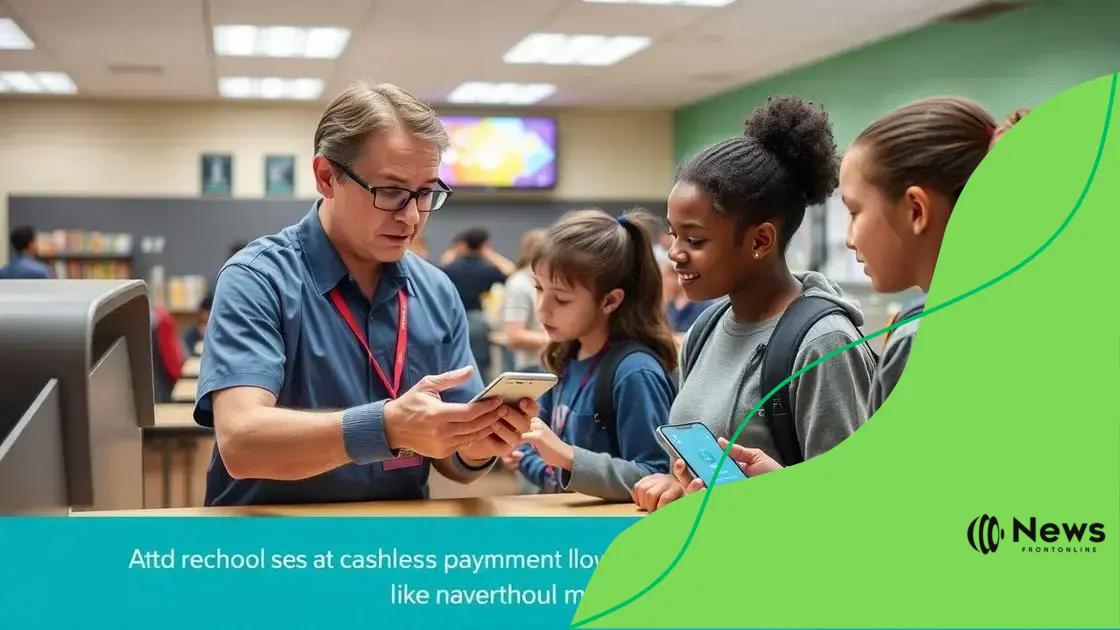Cashless payment rollout in school meals: a necessity
The rollout of cashless payment systems in school meals enhances convenience, security, and efficiency, allowing students to make quick transactions while providing schools with better financial management capabilities.
The cashless payment rollout in school meals is changing the way students enjoy lunch. Imagine a world where kids skip the lines and have their meals paid for with just a tap. Let’s dive into what this means for our schools.
Understanding cashless payment systems
Understanding cashless payment systems is essential as schools transition toward modern meal payment solutions. These systems are designed to make the payment process simpler for students and parents alike. By removing the need for cash, schools can create a more efficient and convenient environment during lunch hours.
How Cashless Payment Systems Work
Cashless payment systems primarily rely on technology to facilitate transactions. Typically, students use cards or mobile apps to pay for their meals. This means no more fumbling for change or dealing with lost lunch money.
Benefits of Cashless Payments
Transitioning to a cashless system brings several advantages:
- Speed: Transactions are quicker, allowing students more time to enjoy their meals.
- Security: Reduces the risk of lost or stolen cash.
- Budgeting: Parents can easily monitor and manage their children’s meal spending.
- Hygiene: Minimizes physical contact and helps maintain cleanliness in cafeterias.
Moreover, cashless systems can include features like online account management for parents. This allows them to add funds remotely and check their child’s spending habits. The integration of technology not only aids in managing funds but also provides insights into purchasing patterns. Schools can then tailor menus based on what students prefer most.
It’s important for schools to provide training for both staff and students to ensure smooth adoption of these systems. With proper guidance, everyone can become familiar with the new methods of payment quickly. A positive attitude towards adopting cashless payment systems can lead to an overall improved experience during school meals.
Benefits of cashless payments in schools
The benefits of cashless payments in schools extend far beyond just convenience. Implementing a cashless system can enhance the overall dining experience for students while also streamlining operations for schools. Parents and students alike appreciate the efficiency and security that comes with this modern payment method.
Enhanced Convenience for Students
Cashless payments allow students to pay for their meals quickly. Imagine students moving through the lunch line in a matter of seconds. This system drastically reduces wait times and helps students enjoy their breaks more fully.
Improved Financial Management
Cashless systems provide better control over school finances. They allow schools to track transactions more accurately. This means less cash handling, which can also lead to reduced theft or loss.
- Simpler Tracking: Schools can easily monitor meals served and payments received.
- Budget Control: Parents can set spending limits on their children’s accounts.
- Instant Transactions: Payments are processed immediately, reducing the need for cash flow management.
Furthermore, cashless payments help schools provide better meal options that reflect student preferences. They can analyze spending data to adjust menus and improve food selections. This means students are more likely to enjoy and consume healthy meals that meet their dietary needs.
Another major benefit is the hygiene factor. Using cashless systems limits physical contact between individuals, promoting cleanliness in the cafeteria. This aspect is especially important in maintaining health during flu seasons or pandemics.
In conclusion, adopting cashless payments in schools addresses numerous challenges related to traditional payment methods, ensuring a smoother and safer experience for everyone.
Challenges in implementing cashless systems

The challenges in implementing cashless systems in schools can be significant, yet understanding them is the first step in overcoming these hurdles. Transitioning from cash to cashless payment methods requires careful planning and execution. Schools must be prepared to address various obstacles that may arise during this process.
Technical Issues
One of the primary challenges is ensuring that the necessary technology is in place. Schools need reliable internet connections and the right hardware. Without a good system, transactions can lag, creating frustration for students and staff. It’s essential to have a backup plan, such as a manual entry system, for times when technology might fail.
Training and Education
Training is crucial for both staff and students. Proper education on how to use the new systems is necessary for a smooth transition. Schools need to invest time in training sessions that familiarize everyone with the cashless process. Misunderstandings or lack of knowledge can lead to errors, which may cause delays and dissatisfaction.
- Staff Training: Educators and cafeteria workers must understand how to operate cashless systems.
- Student Orientation: Students should receive support in using their payment cards or apps.
- Parent Communication: Schools must update parents on how to manage their children’s accounts effectively.
Another challenge is managing the financial aspect. Some schools may encounter budget constraints when implementing new systems. Finding funding for technology upgrades, maintenance, and training can be difficult. Additionally, ongoing costs related to transaction fees can also impact school budgets.
Resistance to change can be a barrier as well. Some parents and staff may prefer traditional cash transactions and feel uncomfortable with cashless methods. Addressing concerns through open communication and providing clear benefits can help ease these worries. Establishing trust in the new system is crucial for its success.
The role of technology in school meals
The role of technology in school meals is increasingly important as educational institutions embrace modern solutions. Technology not only streamlines food service operations but also enhances the overall dining experience for students. By leveraging advanced systems, schools can provide better nutrition and service.
Ordering and Payment Systems
Cashless payment systems are a prime example of technology influencing school meals. With these systems, students can pay quickly and securely, minimizing wait times in cafeteria lines. Mobile apps and smart cards allow for convenient access to meal plans. Parents can also manage their children’s accounts online, ensuring adequate funds and tracking spending.
Menu Management
Technology helps schools create dynamic menus that can adjust to student preferences. Digital platforms can analyze purchasing data, allowing schools to see which meals are popular. With this information, they can offer healthier choices based on actual consumption trends. Furthermore, schools can use technology to inform students about nutritional information, helping them make better eating choices.
- Feedback Mechanisms: Schools can gather feedback from students on meals served, leading to improvements in food offerings.
- Nutrition Tracking: Technology can assist in tracking the nutritional value of meals served, ensuring compliance with health guidelines.
- Online Ordering: Advanced ordering systems can allow students to choose their meals ahead of time, reducing food waste.
Additionally, technology plays a vital role in ensuring food safety. Schools can utilize digital logs to monitor food temperatures and storage conditions, preventing spoilage and ensuring that meals are safe to consume. Automated alerts can notify staff to address any issues quickly, thus enhancing safety protocols.
Incorporating technology into school meals not only improves efficiency but also encourages healthier eating habits among students. Schools are thus able to cultivate an environment where nutrition is prioritized, making meal times both enjoyable and educational.
Future trends in cashless payments for education
The future trends in cashless payments for education promise exciting advancements. As technology continues to evolve, schools are likely to adopt more innovative solutions to enhance the meal purchasing experience. These changes aim to improve convenience and accessibility for students and parents alike.
Mobile Payment Integration
One major trend is the increasing integration of mobile payment options. Students will soon be able to use their smartphones for transactions, making payments even more convenient. This could include QR codes or mobile apps that allow for quick and secure purchases, eliminating the need for cash or physical cards.
Biometric Payment Solutions
Biometric payment systems are also on the rise. Schools may implement technology that uses fingerprints or facial recognition to process transactions. This approach is not only secure but also speeds up the checkout process, ensuring students have more time to eat.
- Increased Security: Biometric systems can greatly reduce the risk of fraud.
- Streamlined Transactions: Payments can be completed in seconds.
- User-Friendly Experience: Students won’t have to remember PINs or carry cards.
Another trend focuses on data analytics. Schools will leverage data to monitor spending patterns and adjust menus accordingly. Advanced analytics can help schools understand which meals are popular, allowing them to tailor offerings to meet student preferences.
Moreover, schools may adopt blockchain technology for secure transactions and record-keeping. This innovative approach can increase transparency and efficiency in managing funds. Parents could even receive notifications each time their child makes a purchase, keeping them informed about their spending habits.
The future will also see an emphasis on sustainability. Eco-friendly payment options, such as digital receipts and reduced paper usage, align with growing environmental concerns. Schools can take a meaningful step towards reducing waste while still providing excellent meal services.
In conclusion, the shift to cashless payment systems in schools offers numerous benefits while also presenting challenges. These systems enhance convenience and security for students and parents, allowing for a more seamless lunch experience. As technology advances, schools will find new ways to improve meal service, making it more efficient and tailored to student preferences. It’s crucial for schools to address the challenges of implementing these systems effectively. By doing so, they can ensure a positive transition that promotes healthy eating habits and fosters financial responsibility among students.
FAQ – Frequently Asked Questions about Cashless Payment Rollout in School Meals
What are the main benefits of cashless payment systems in schools?
Cashless payment systems offer enhanced convenience, security, and quicker transactions for students, making meal times more efficient.
How do mobile payments work in school cafeterias?
With mobile payments, students can use their smartphones or apps to pay for meals, eliminating the need for cash or physical cards.
What challenges might schools face when implementing cashless systems?
Schools may encounter technical issues, resistance to change, and the need for adequate training for staff and students.
How can technology improve meal selection in schools?
Technology can analyze purchasing data to tailor menus based on student preferences, making it easier to provide healthier meal options.





